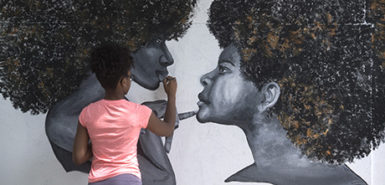
With all that is going on in the world right now, there may be no better time to have a discussion with your children about race and racism.
Spectrum Health Helen DeVos Children’s Hospital experts weighed in on how to best discuss this with your kids, and shared their top tips. The experts included division chief for adolescent medicine Lisa Lowery, MD, and pediatric psychologists Adelle Cadieux, PsyD, and Brittany Barber Garcia, PhD.
Dr. Lowery said this is a teachable moment for kids.
“We are now talking about things that have been going on for hundreds of years, but this newer generation has not seen much of protests in their lives, including everything that has led up to this,” she said. “It’s so easy to focus on the negative. We need to focus on the positive narrative.”
Q: Where do I start when it comes to discussing the topic of racism with my kids?
Dr. Lowery: The best “talk” you can have is by leading with your own actions and thinking about what example your life presents to your kids. It also starts with acknowledging that racism exists. This depends on your cultural background and knowing that you are going to experience racism either as a victim, witness or bystander in your life. Helping your children develop resiliency and ways to intervene is important. Be certain your kids know to tell a teacher or other adult if they see something and stress the importance of standing up for someone when they see them being treated inappropriately. You can also mention that some people are going to treat you differently or wrong simply because you like, talk or act differently.
Dr. Cadieux: It’s important to acknowledge that racism exists and that bad things have and do happen because of racism. Ask your child what they think racism is, what they have learned about racism and what questions they have about it. This allows you as a parent to address misconceptions and answer the questions that are important to your child. Leave the door open so your child knows it’s OK to ask more questions later or to bring the topic up again.
Dr. Barber Garcia: I believe you start by starting. These can be difficult and intimidating conversations to begin having, but the longer parents wait, the more difficult they will become. If you haven’t started talking to your children about race and racism in our country, now is the time. And if you already have been, keep it going and, if it is age appropriate, try to be more nuanced in addressing the complexities of race and racism in the US. It is important to identify your own cultural and racial background, and help your kids begin to identify theirs, so they understand what it means to themselves and to others. This can lead to an important conversation about how to address racism, as Dr. Lowery said, when it is experienced. Because, it will be experienced.
Q: At what age should I start having this discussion?
Dr. Lowery: Toddlers and even infants can notice differences. But I think you can talk about it when opportunities come up such as what is going on right now. You can keep it simple and often.
Dr. Cadieux: It’s OK to acknowledge differences, but also acknowledge and model that differences are not bad and that we can celebrate differences within ourselves and the differences of others.
Dr. Barber Garcia: Acknowledging and celebrating differences for toddlers and young children is appropriate and helpful. By the time kids are starting elementary school, it’s appropriate to teach them what race is and to begin asking questions about what they see and notice about how people are treated and what questions they have.
Q: How do I adapt the message differently by age?
Dr. Lowery: Keep it age appropriate. Sometimes when little kids notice differences, that’s a good time to engage. And it doesn’t have to be just one talk, but ongoing conversations.
Dr. Cadieux: This is where asking your child what questions they have can help your response. Reply honestly even if sometimes that means acknowledging difficult realities and even when it means we have to say I don’t know or I’m not sure.
Dr. Barber Garcia: Of course, the discussions will look different as children grow and mature, but it is never too late to start, and having ongoing conversations that change over time is necessary and helpful.
Q: When I talk about race and racism, what should I say?
Dr. Lowery: In your discussions, be simple and consistent and, most importantly, listen.
Dr. Cadieux: Be honest that it exists, talk about how to treat others, and model acceptance, respect and empathy.
Dr. Barber Garcia: It is important to define race and racism in simple and clear terms. It is then important to ask questions and listen to what your kids have to say and respond to their thoughts.
Q: As a parent, what can I do?
Dr. Lowery: Educate yourself and demonstrate cultural sensitivity. Be aware and acknowledge that you have biases, whether implicit or explicit. I also think the best teaching is living a life that’s an example.
Dr. Cadieux: Modeling is a great way to teach our children. Model acceptance and respect. Model standing up for others. When current events happen, talk to your kids about what they have seen or heard and what questions they have about it. It’s OK to acknowledge that bad things happen, but also limit the amount of exposure they have of the event so that they are not reviewing the event repeatedly.
Dr. Barber Garcia: I would add that as a parent, we can also provide our children with materials and information that not only discuss race and racism, but also celebrate the stories of people of color.
 /a>
/a>
 /a>
/a>
 /a>
/a>
Thank you, Rick! Excellent work as usual. And thank you to your interviewees for this important discussion.